Due to the economic and political growth of Pest, it became a national centre by the middle of the 19th century. It became the country's capital after the Austro-Hungarian Compromise. The number of restaurants and hostels increased with the city's growth, and over time, significant differences formed between them in terms of quality, services and, of course, prices.
The most prestigious hotels in the city, which according to contemporary reports were large, palace-like buildings, lined today's City Centre in the 1840s. The Nádor and Hét Választófejedelem on Váci Street, the Vadászkürt Inn on the corner of Kis híd (now Türr István) and Aranykéz Streets and another inn called Magyar Király on Színház (today Vörösmarty) Square.
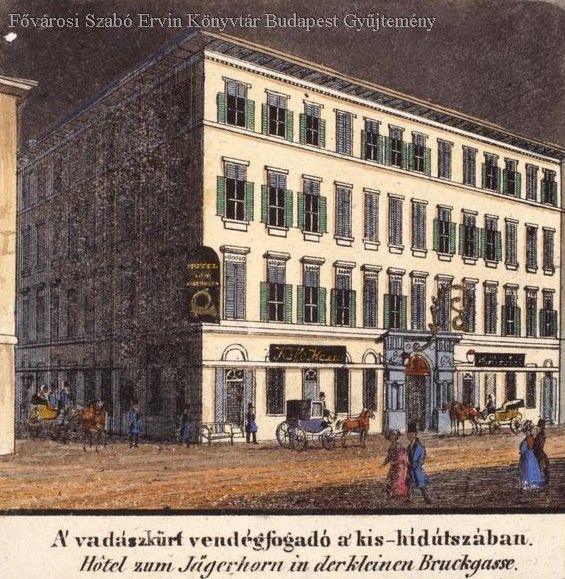
The Vadászkürt Inn on the corner of Kis híd (now Türr István) and Aranykéz Streets, in the graphic by Carl Vasquez in 1837 (Source: FSZEK Budapest Collection)
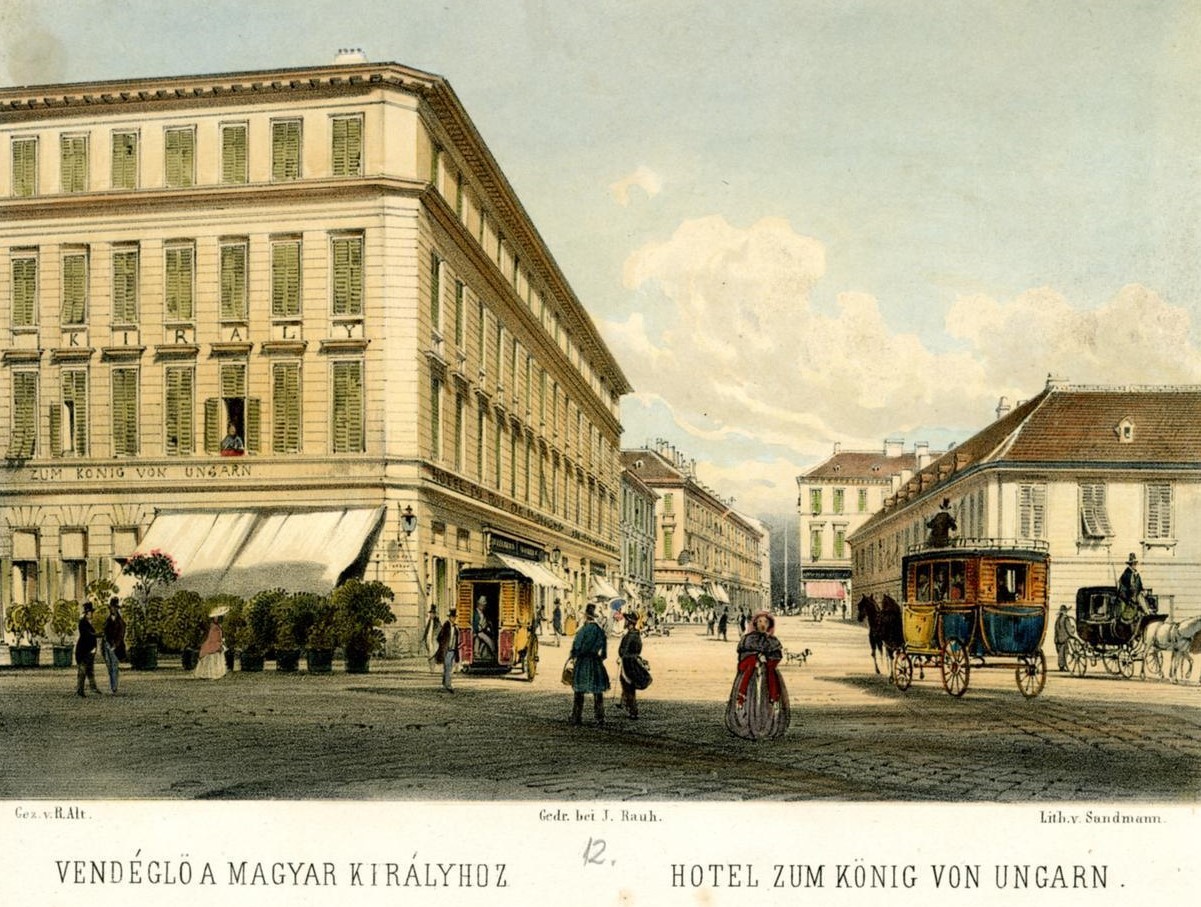
The Magyar Király hotel and its terrace on Színház (now Vörösmarty) Square on the graphic by Rudolf Alt in 1850 (Source: FSZEK Budapest Collection)
The other popular site was the Danube Bank, where the embankments had not yet been built. Buda compensated for this, offering a beautiful panorama. Although the Buda Castle suggested the character of a fortress, the Danube and the Buda Hills still provided a pleasant sight.
It is no wonder that there were upscale hotels among the classicist houses. The István Főherceg Hotel on the corner of today's 1 Akadémia Street and the former Rakpiac; the Európa Hotel opposite Chain Bridge formed in the Ullmann and Wieser Houses (today's 7–8 Széchenyi István Square); or the Angol Királynő on the side of Nagy híd (present-day Deák Ferenc) Street facing Redoute (former Pest Vigadó).
Each hotel usually had two dining rooms: one on the ground floor and the other on the first floor. Some of the restaurants on the ground floor had an outdoor terrace decorated with flowers, reminiscent of a garden, where guests were entertained with music during lunch and dinner.
Of course, the nobility and higher standards were already accompanied by matching prices. Reports from the 1840s wrote that, for example, in the Angol Királynő, an icce (old Hungarian liquid measure, ~ 0,84 litre) of water was offered for six pennies while in Kecskemét, wine was offered for half of that. Of course, the correspondent did not forget to note that water was better in the Angol Királynő than the wine in Kecskemét.
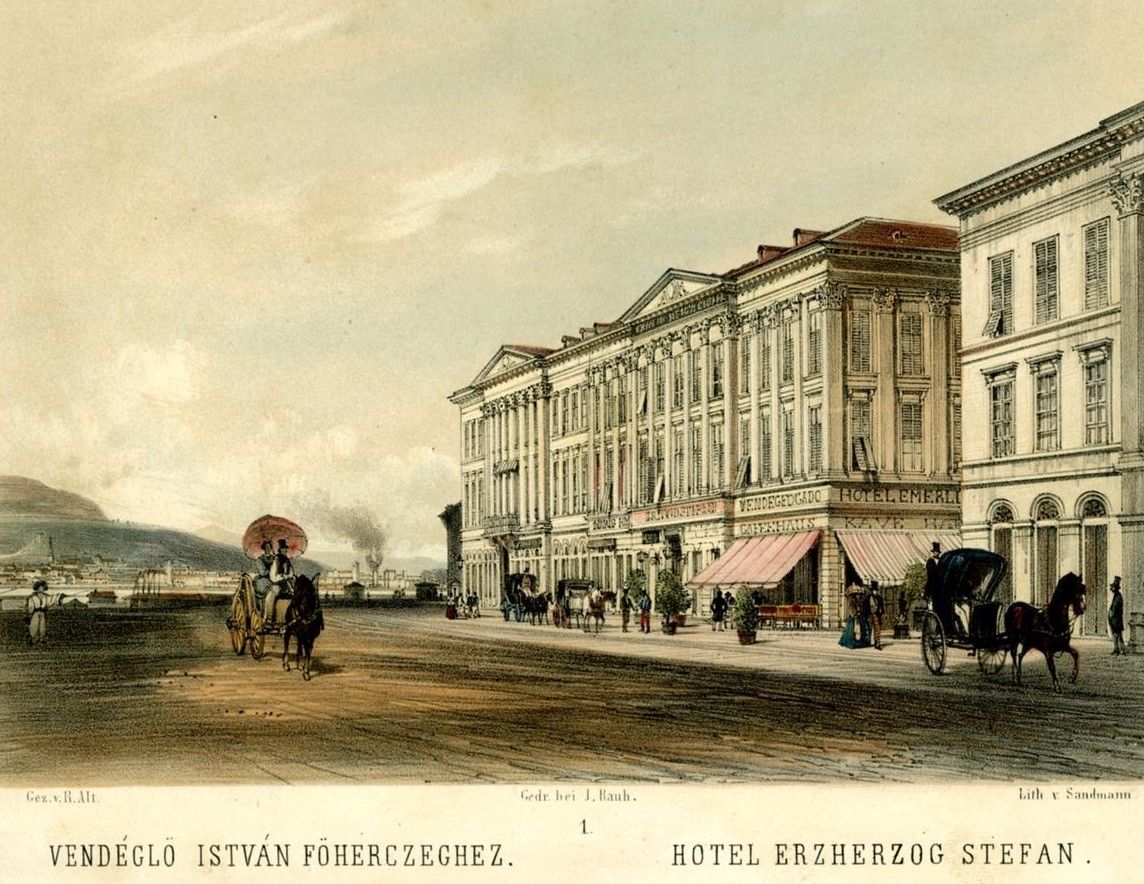
The István Főherceg Hotel and its terrace on the corner of 1 Akadémia Street and the former Rakpiac in the graphic by Rudolf Alt in 1850 (Source: FSZEK Budapest Collection)
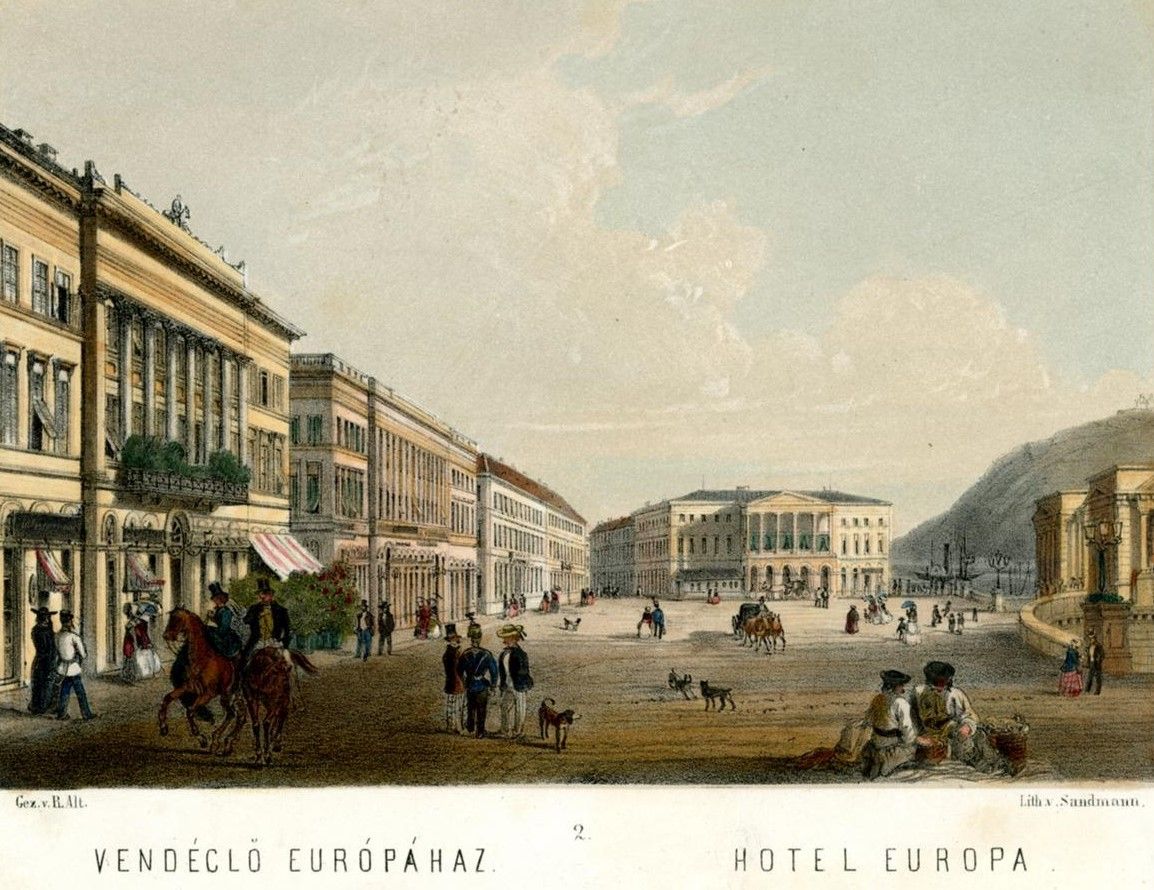
The Európa Hotel opposite Chain Bridge (now 7–8 Széchenyi István Square) on the graphic of Rudolf Alt in 1846 (Source: FSZEK Budapest Collection)
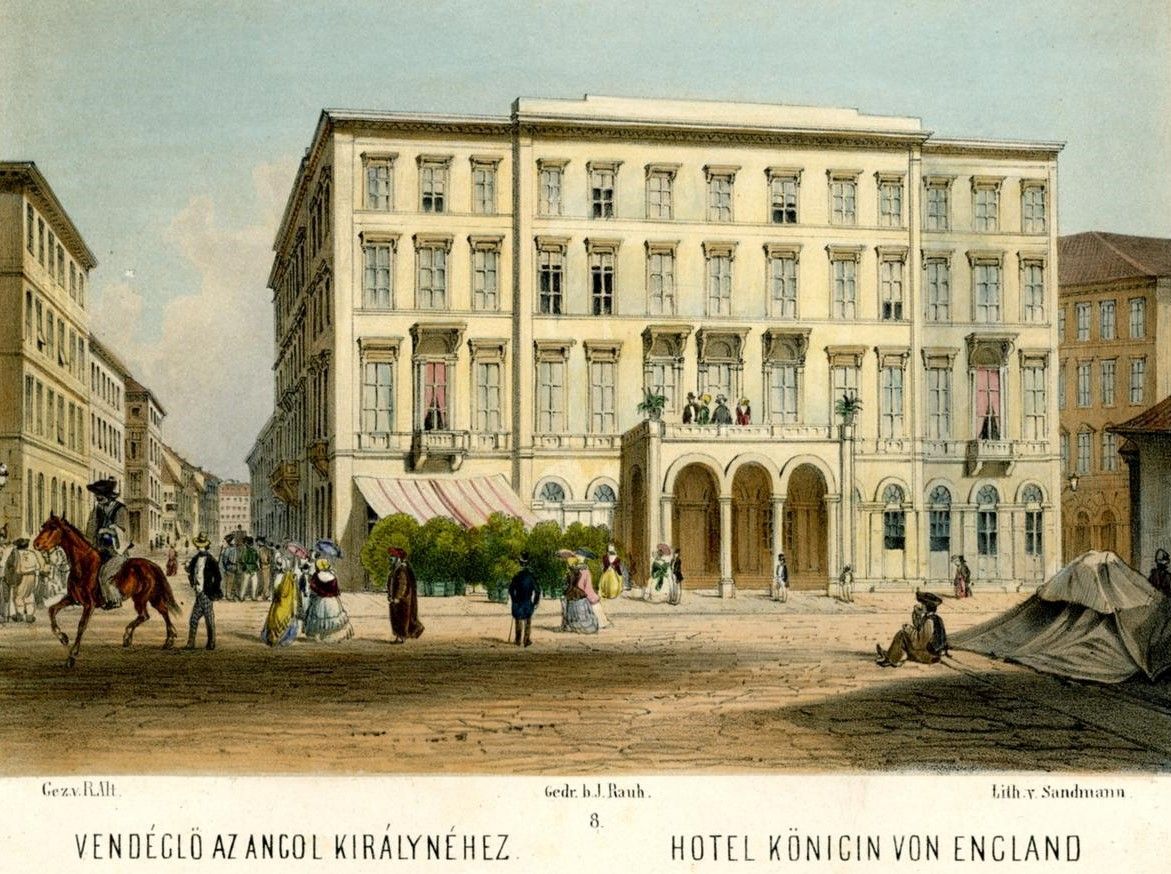
The Angol Királynő Hotel and its terrace on the side of Nagy híd (today's Deák Ferenc) Street facing Redoute (former Pest Vigadó) in the graphic of Rudolf Alt in 1850 (Source: FSZEK Budapest Collection)
The construction of the embankments (south of the Chain Bridge, to today's Erzsébet Bridge) in the 1850s and 1860s enriched the area in front of the row of classicist buildings made in the 1830s and 1840s with a valuable and suitable land for construction. Over time, upscale hotels opened here, creating an outstanding venue for hospitality in Pest. The value of the newly won area was still provided by the panorama of Buda coupled with the proximity of the Danube, which meant an increasingly beautiful and elegant cityscape and a unique milieu.
At the beginning of the 20th century, the Danube Promenade was famous for its promenade and the hotels. The foundations of this were laid by the Grand Hotel Hungária, built in the early 1870s, which resulted in a slow, decades-long transformation towards tourism and hospitality.
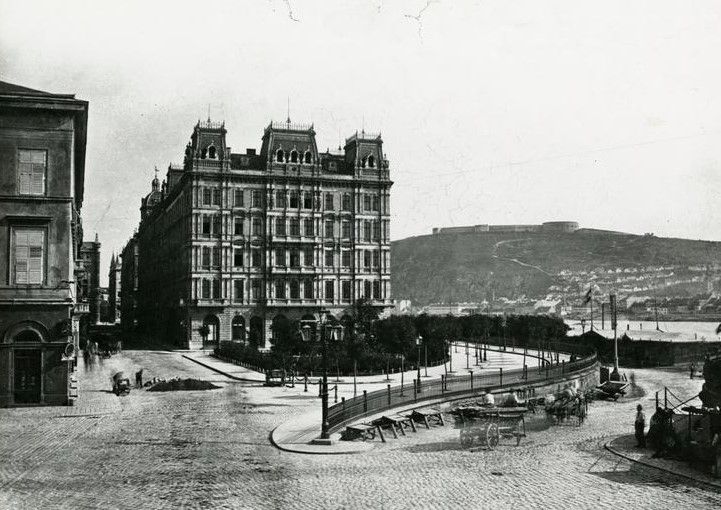
The apartment building of the grain trader Nathan János Stein in the 1880s by György Klösz (Source: FSZEK Budapest Collection)
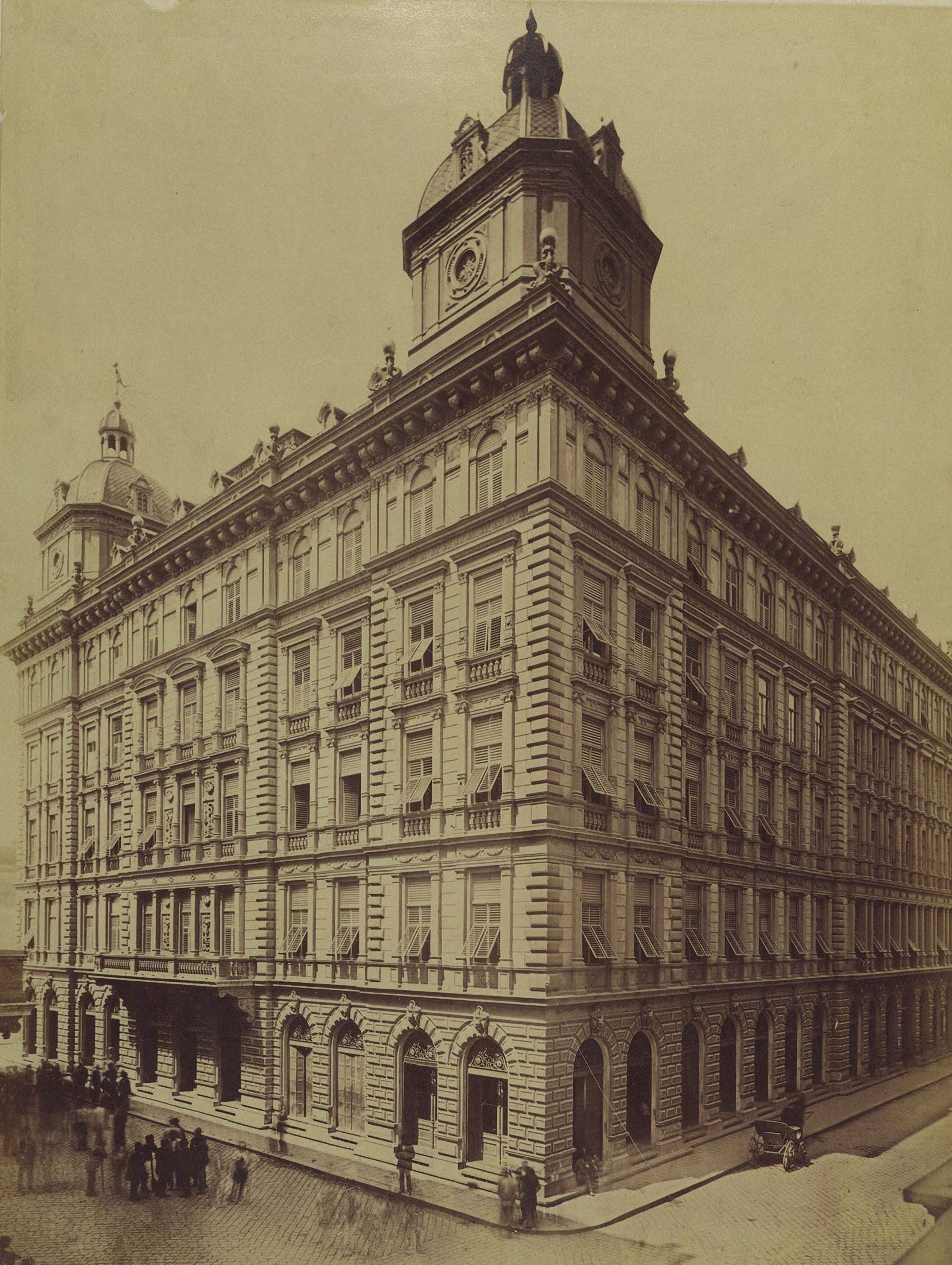
The Lloyd Company, the headquarters of the Budapest Commodity and Stock Exchange (BÁÉT) in the 1880s, photographed by György Klösz (Source: Fortepan/No.: 82125 / Budapest Archives Ref. no.: HU.BFL.XV.19.d.1.05.070)
The centre of the area taken from the Danube was the square in front of Vigadó. Five plots were created to the north and six to the south, for which investors were sought in 1866. Only five of the six to the south were eventually sold.
People and companies of economic interest bought the building sites. Going from north to south, one of the five sites north of Vigadó was owned by the grain trader Nathan János Stein's, two were the Lloyd Company's, and two were the Thonet Brothers', who were the owners of the famous furniture factory of the age.
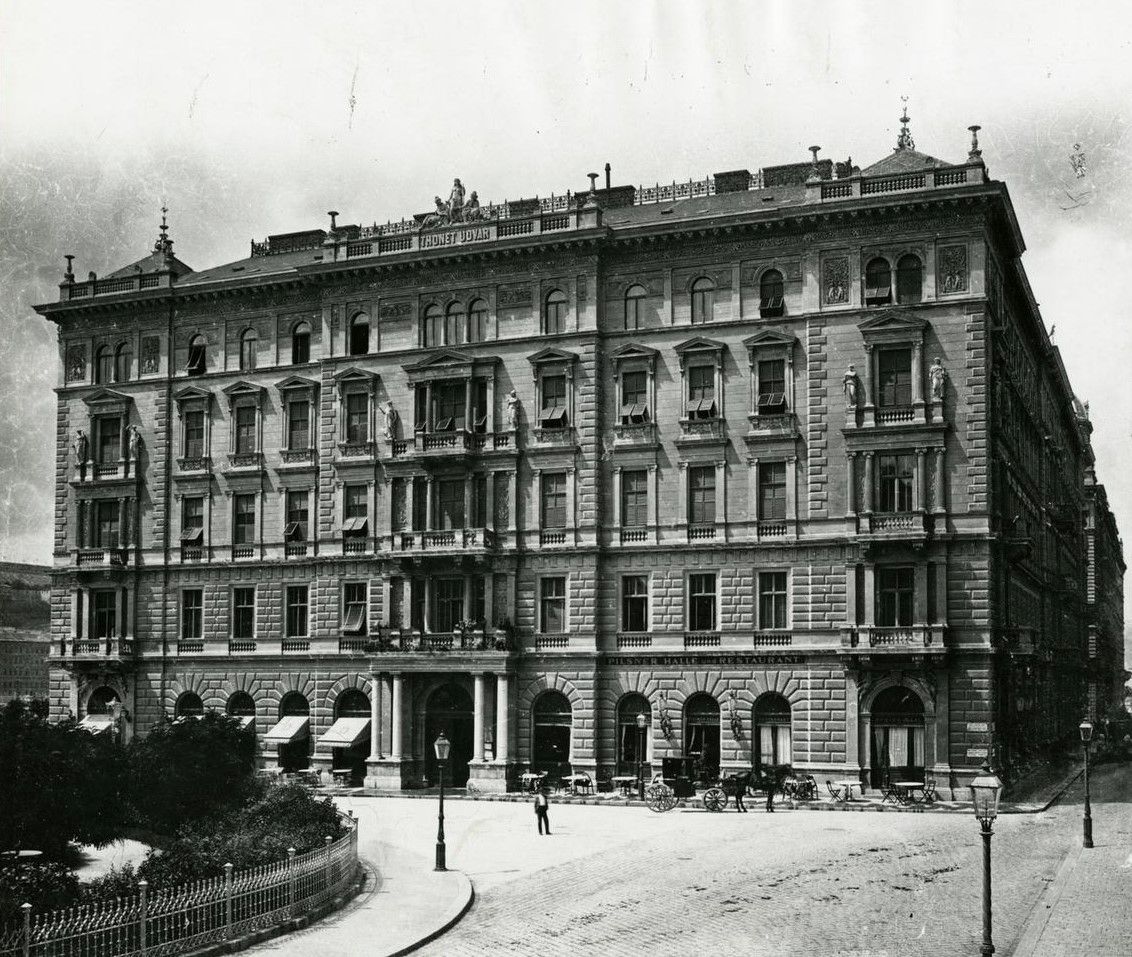 The Thonet Court in the 1870s by György Klösz (Source: FSZEK Budapest Collection)
The Thonet Court in the 1870s by György Klösz (Source: FSZEK Budapest Collection)
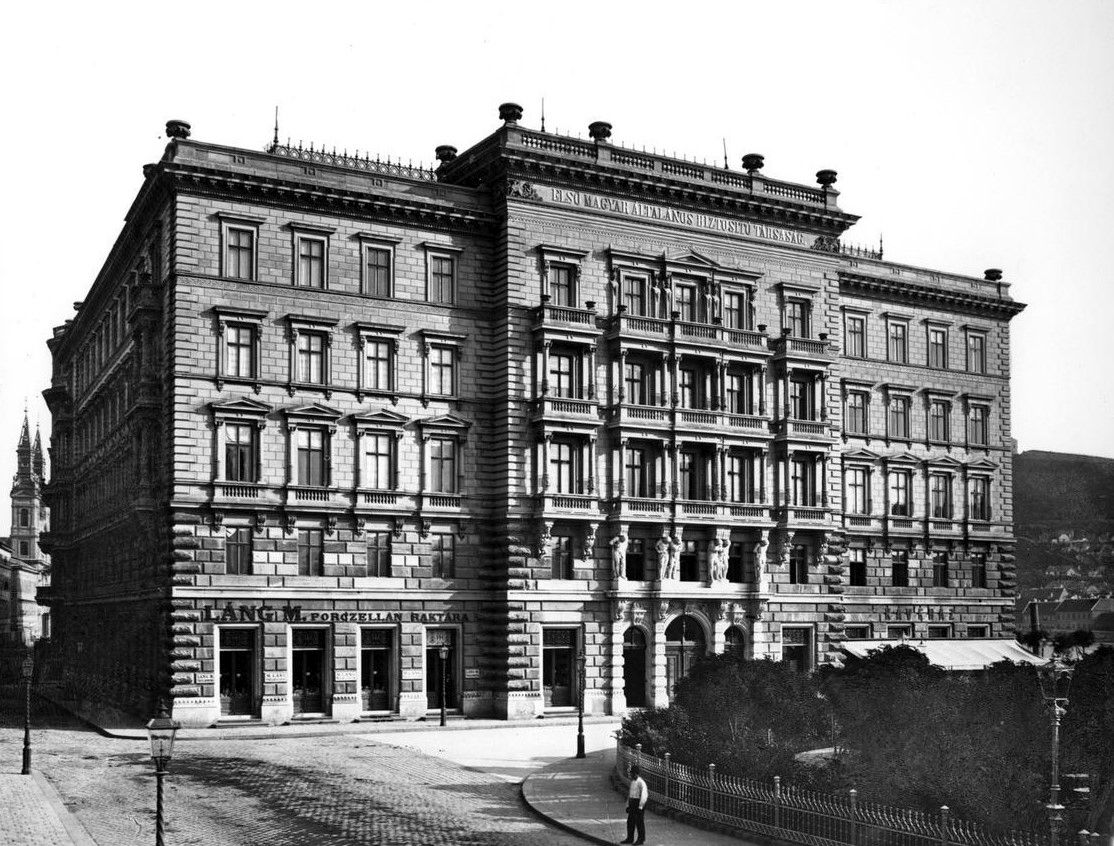
The headquarters of the First Hungarian General Insurance Company on Vigadó Square in the 1880s by György Klösz (Source: FSZEK Budapest Collection)
South of Vigadó, one site was bought by the First Hungarian General Insurance Company, two by the First Hungarian Hotel Public Limited Company, one by Henrik Lévay, the director of the First Hungarian General Insurance Company, and another one by István Heinrich, an entrepreneur, homeowner.
The outstanding value of the area was indicated by the fact that the Thonet Brothers paid 404,000 forints for the site, which was the highest price ever paid for a plot in Pest.
Only one palace on the Danube Promenade built during this period was designed to be a hotel: the Grand Hotel Hungária. The rest served other purposes, mainly functioning as headquarters and residential buildings.
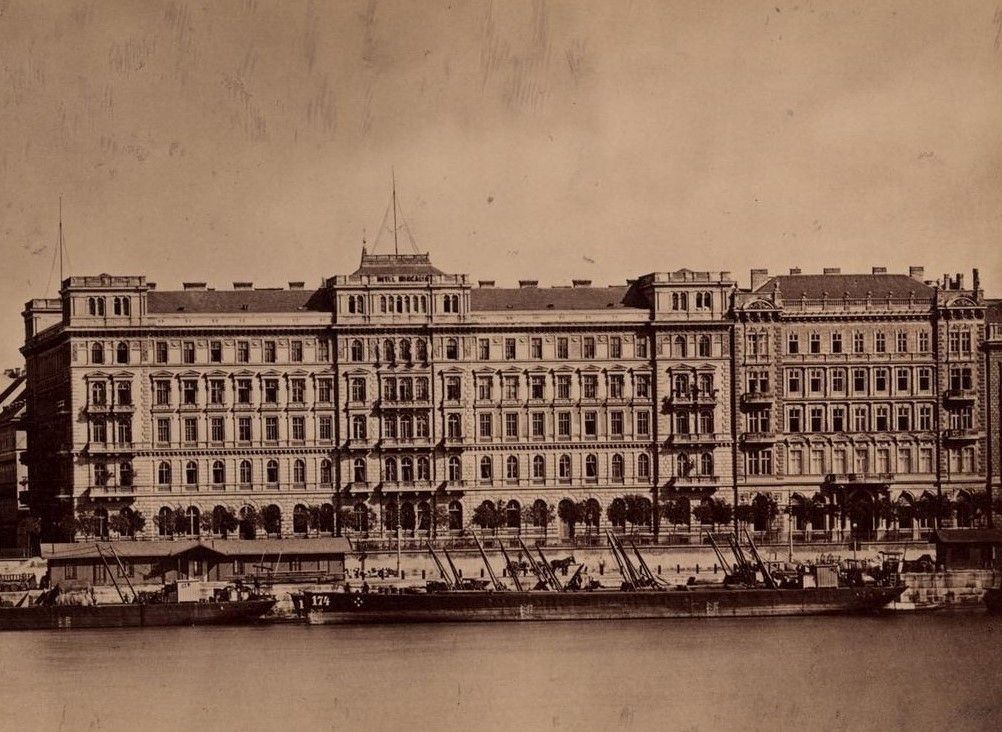
Grand Hotel Hungária and to its right, the residential building owned by Henrik Lévay, the director of the First Hungarian General Insurance Company in the 1880s by György Klösz (Source: FSZEK Budapest Collection)
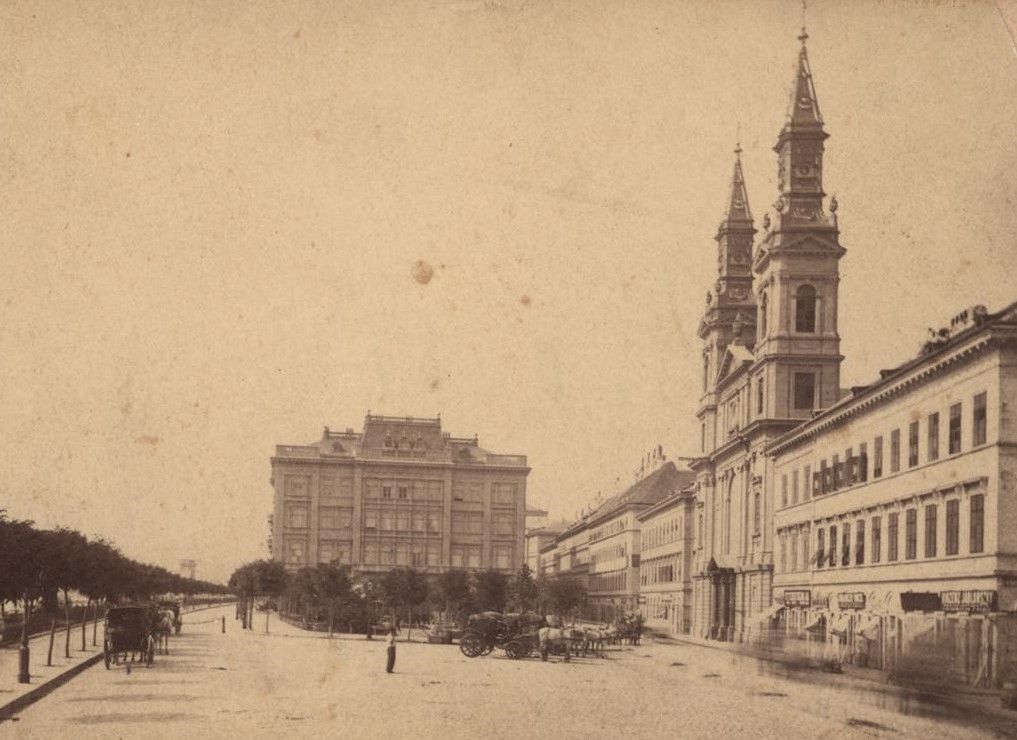
István Heinrich's entrepreneur, homeowner's residential building in the 1870s (Source: FSZEK Budapest Collection)
In the second half of the 19th century, significantly improved transport conditions, the construction and development of the railway network brought an increase in the desire to travel and a boom in tourism. The city was an attraction for all those who enjoyed getting to know the world of other regions and cultures.
There was a growing demand for hotels that provide temporary stays as well as comfort. All this greatly contributed to the transformation of the buildings on Danube Promenade into hotels.
The example was the Grand Hotel Hungária, and its foundations were laid by the owner, József Illits, in the year of the millennium, which meant a large-scale construction and transformation in the city's life. Illits expanded with the hotel in the direction of the neighbouring Lévay and Heinrich buildings. The two buildings were converted into a hotel in 1896 and awaited guests as the Bristol from 1 May.
The opportunity was partly given and perhaps originally designed as such. Namely, when the First Hungarian Hotel Public Limited Company bought a building site here, it also bought the plot next to it, where, according to the first construction application plans, they also wanted to build a hotel.
However, the plot was sold to Henrik Lévay, the director of the First Hungarian General Insurance Company, who built a four-storey residential building according to the plans of István Linzbauer. The insurance company built its headquarters on the south side of the square in front of Vigadó.
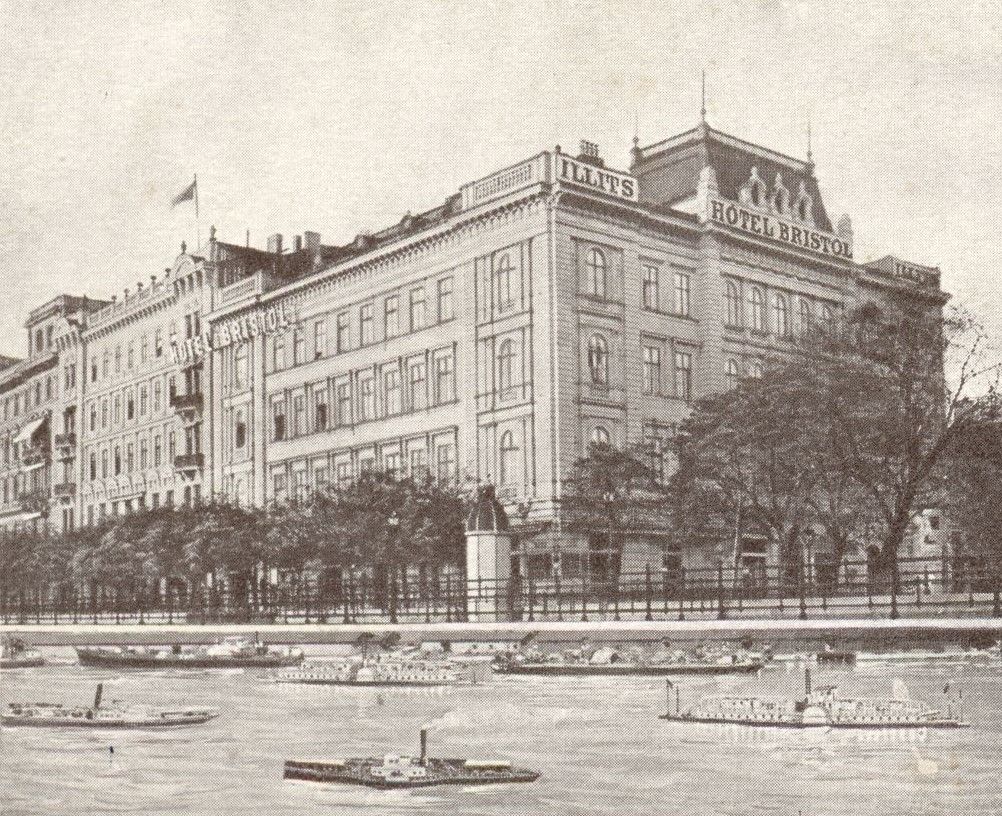
Illits's Bristol Hotel was housed in the five-storey Lévay House and the four-storey Heinrich House (Source: Hungarian Museum of Trade and Hospitality - Budapest, No.: VF 9733)
It was clear at the Bristol Hotel – in contrast to the Grand Hotel Hungária building – that it was not created based on a unified concept, but from the merging of two houses, originally not built as hotels and designed by two different architects.
The striking difference was in the number of floors, as the northern part of the hotel – the former Lévay House – was five storeys high, while the southern part – the former Heinrich House – had four floors. Another floor was only added in 1896, according to the lóplans of Lajos Wagner. The hotel retained its function but became a separate building again. Due to difficulties paying rent, the Bristol was split in 1926, and in the south, on the site of the former Heinrich House, the Carlton Hotel opened its doors.
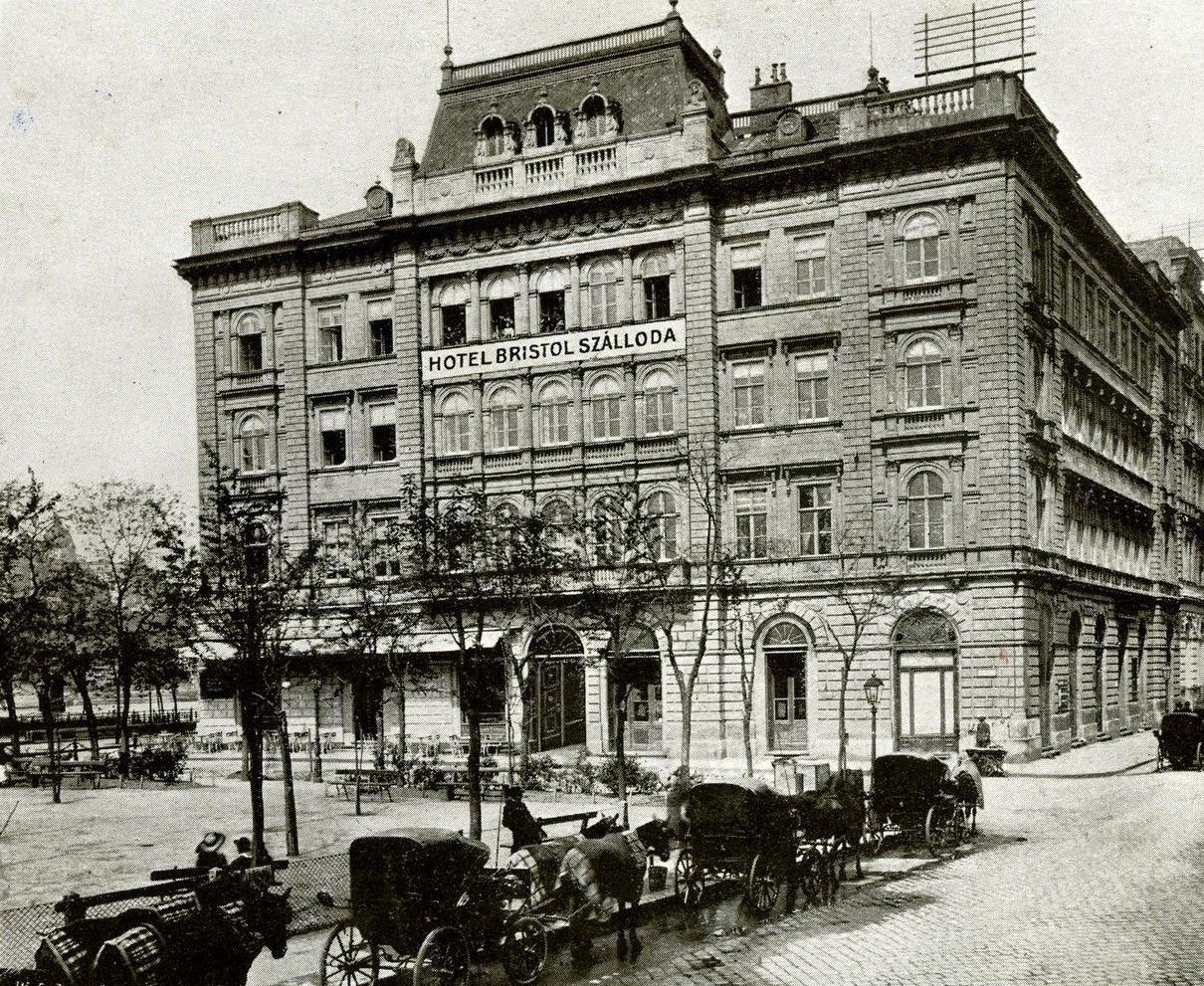
The Bristol Hotel in 1900 (Photo: FSZEK Budapest Collection)
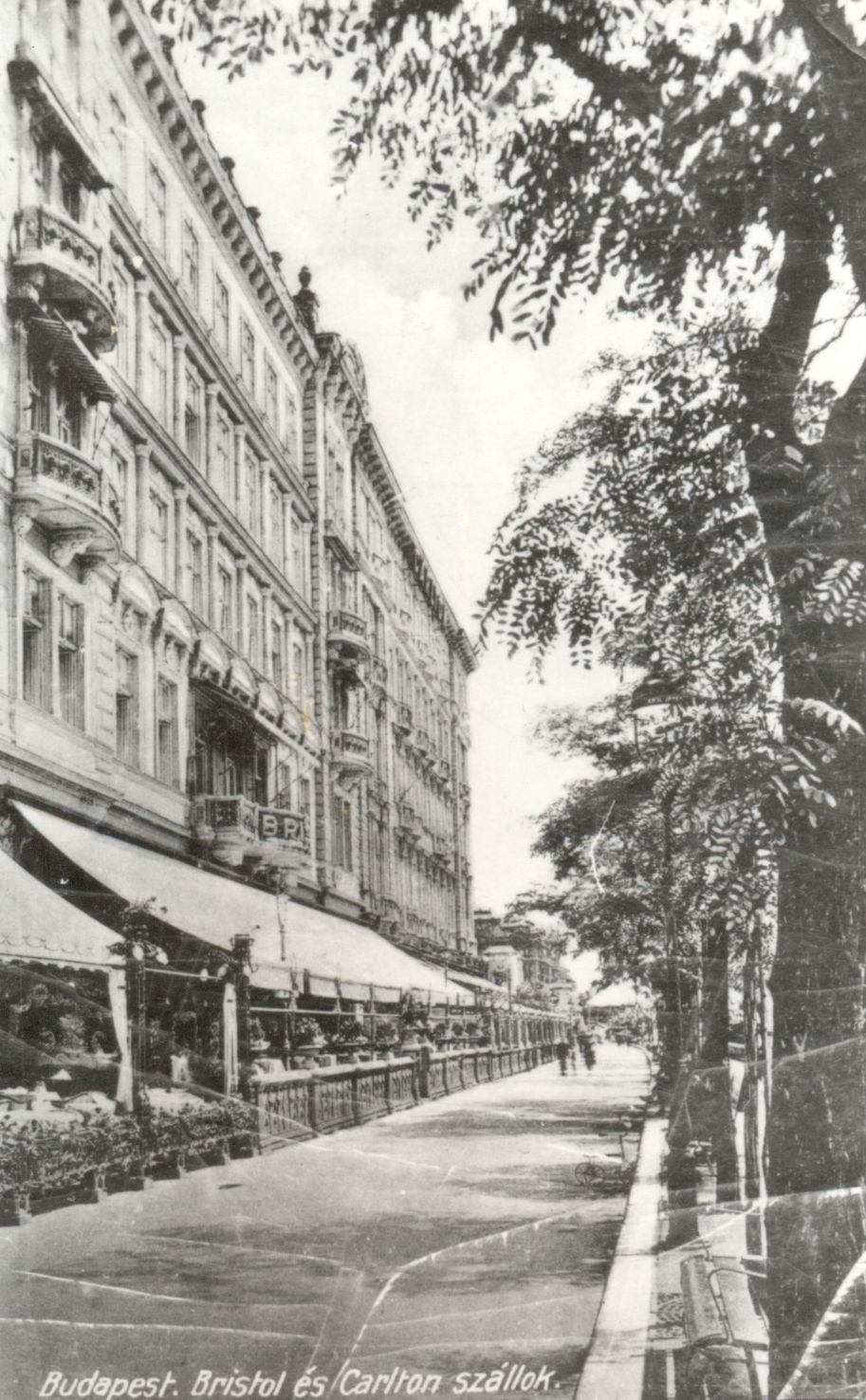
The Bristol and Carlton Hotels, split in 1926, from the Danube Promenade in 1943 (Source: Hungarian Museum of Trade and Hospitality - Budapest, No.: VF 25933)
The development of the hotel row launched on the lower Dunasor also impacted the buildings north of Vigadó. Some of the houses that looked like palaces were transformed into upscale catering establishments.
The biggest change was that the northernmost building, the house owned by Nathan János Stein, after several changes of ownership, was transferred to the London-based Ritz Hotel Development Company in 1909. Before, according to some sources, the building was in possession of the owner of Grand Hotel Hungária and founder of Bristol, József Illits, for a short time.
Instead of remodelling, the house of Nathan János Stein was demolished by the London-based company around 1910, and a new, Neo-Baroque styled, five-storey, 120-room luxury hotel was built according to the plans of Sándor Fellner and Aladár Sós. The Ritz was a distinguished hotel in the capital at the time. It had every amenity: a lift, a restaurant, a café, a winter and a roof garden.
The hotel was plunged into crisis by World War I and went bankrupt. The building was purchased by Grand Hotel Hungária PLC, belonging to the Dreher concern, which operated the hotel under the name Dunapalota from 1916.
The purchase of the building next to Dunapalota, built by the former Lloyd Company, meant the further development of the hotel row. Several rooms of the building were attached to Dunapalota in 1937. The neighbouring Thonet Court would have played a similar role in 1936, but the plans fell through.
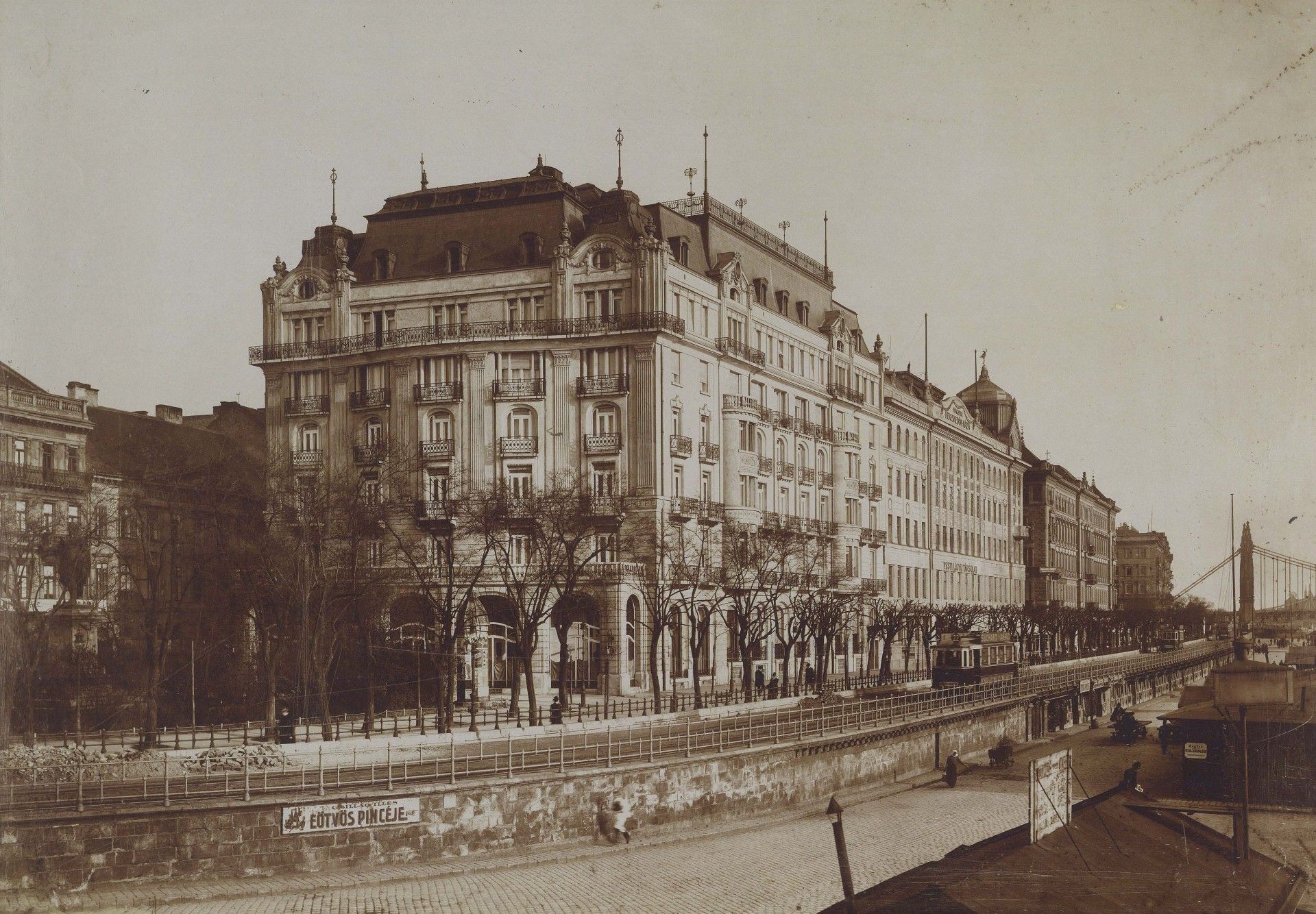
The six-storey Ritz Hotel, which operated under the name Dunapalota from 1916, was photographed by György Klösz (Source: Fortepan/No.: 82608 / Budapest Archives, Ref. No.: HU.BFL.XV.19.d.1.08.083)
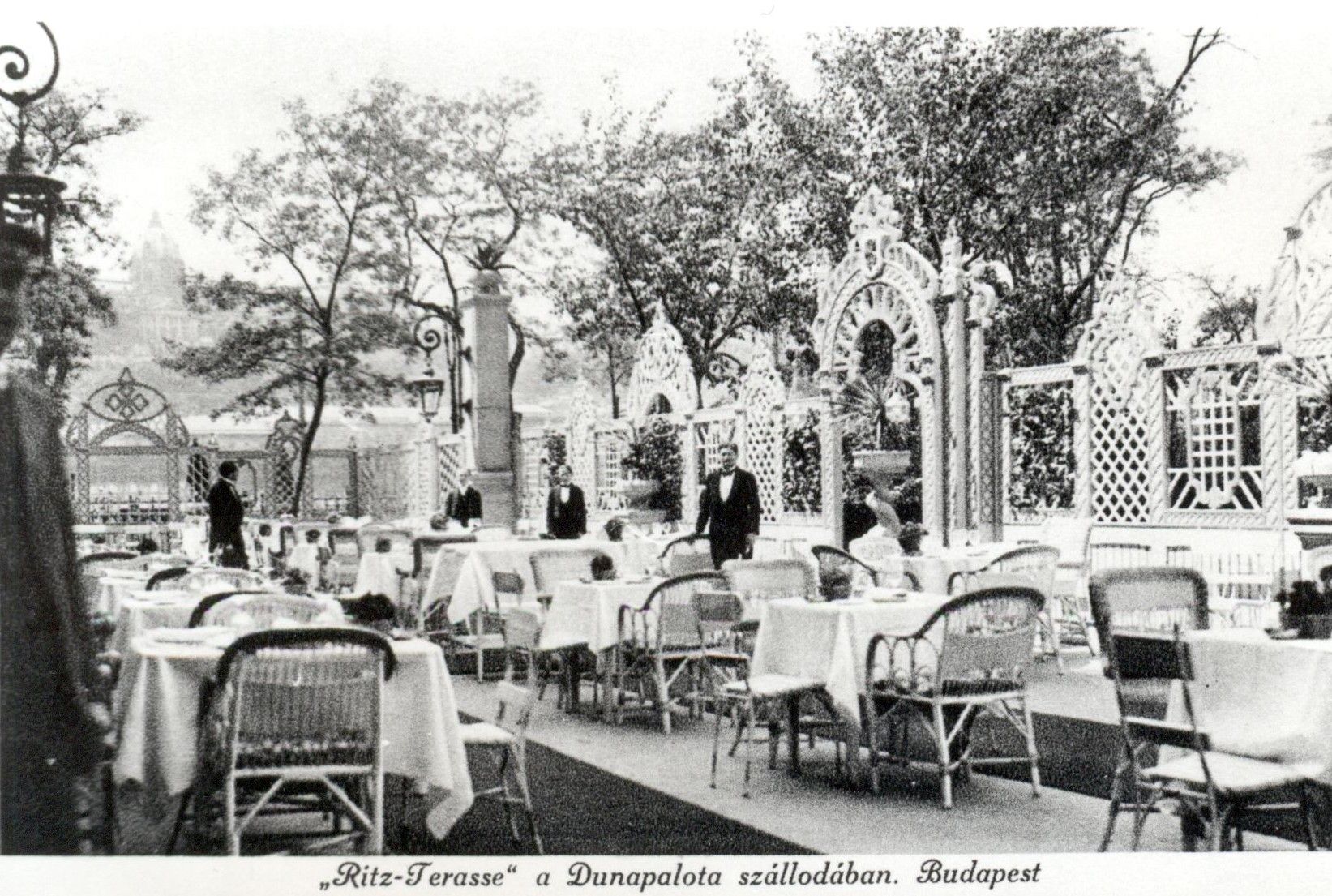
Terrace of the Ritz, later Dunapalota Hotel (Source: Hungarian Museum of Trade and Hospitality - Budapest, No.: VF 38999)
Most of the houses previously built by individuals or various companies along the Danube Promenade were converted into hotels by the second half of the 1930s.
World War II wreaked great havoc in the area, as most of the buildings except Thonet Court were bombed and burned. One of the cityscapes' often mentioned and most popular elements abroad, the former elegance and nobility provided by the hotels, fell to the destruction.
Lonely, shattered and collapsed facades, burnt buildings stood instead of bubbly life: only its memory remained. An exception was Bristol, which continued to operate as Danube Hotel from 1948 until 1960.
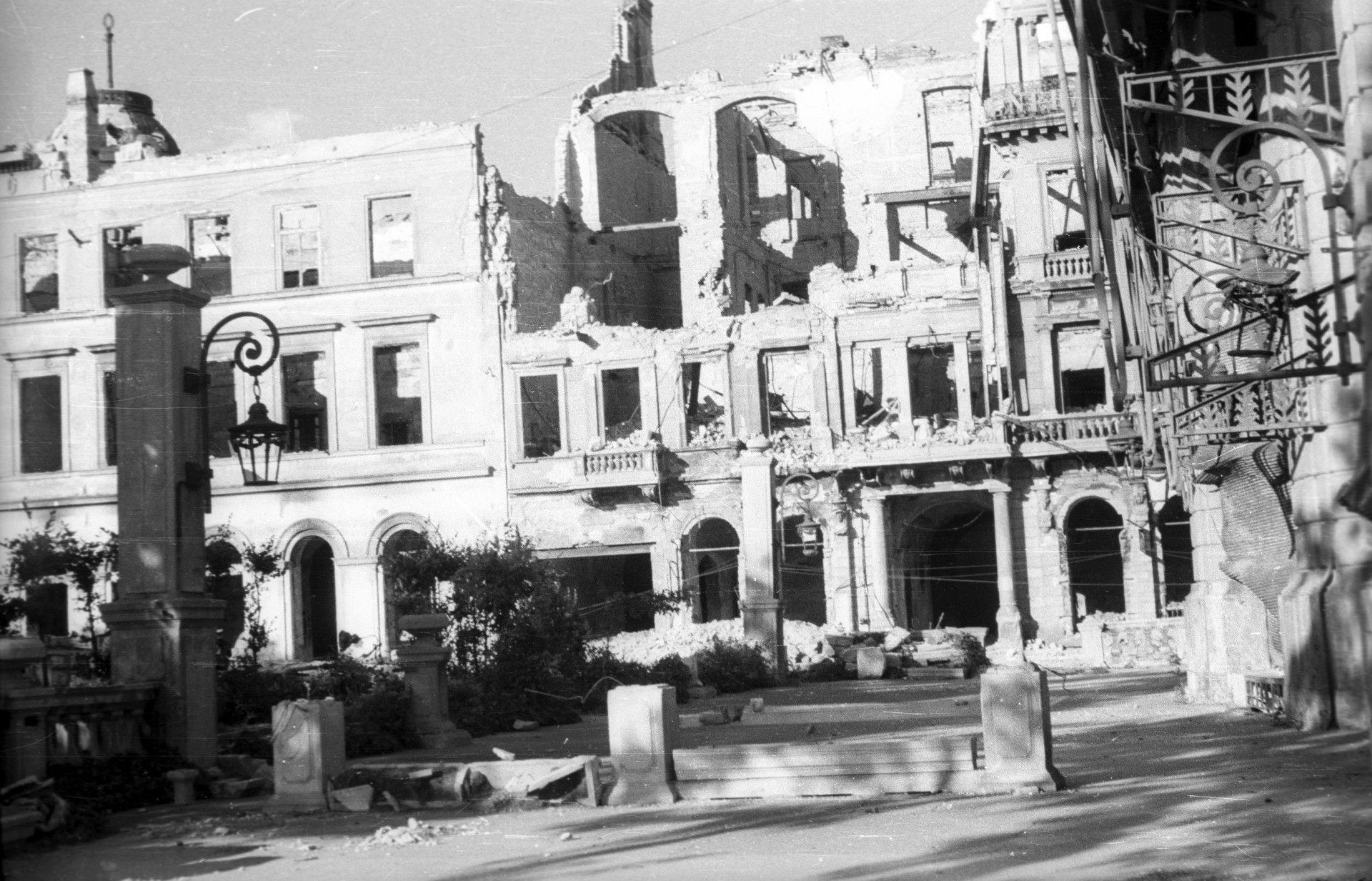
Ruined facade of the Ritz, later Dunapalota in 1945 (Source: Fortepan/No.: 5308)
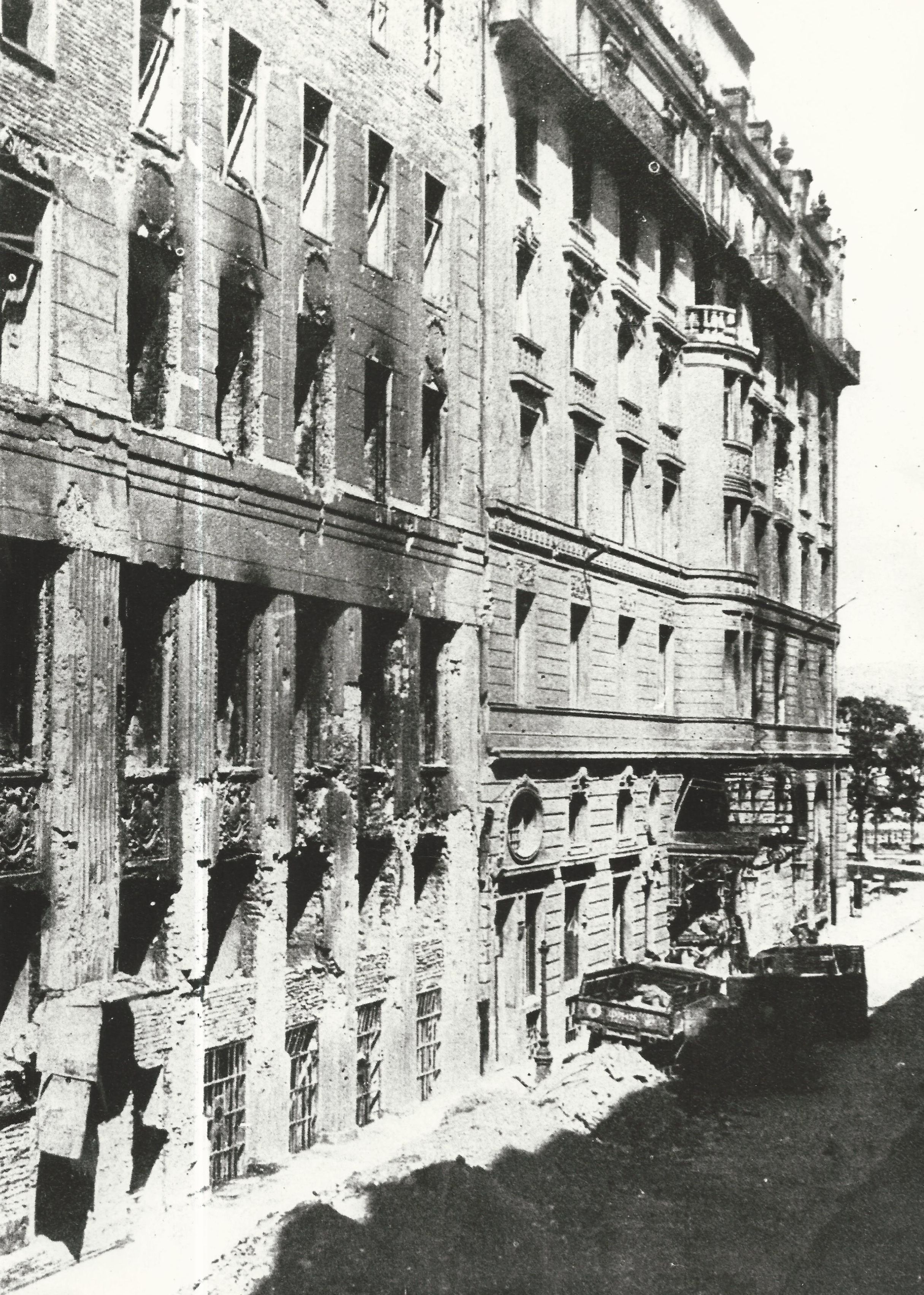
Ruined facade of the Ritz, later Dunapalota in 1945 (Source: Hungarian Museum of Trade and Hospitality - Budapest, No.: VF 22605)
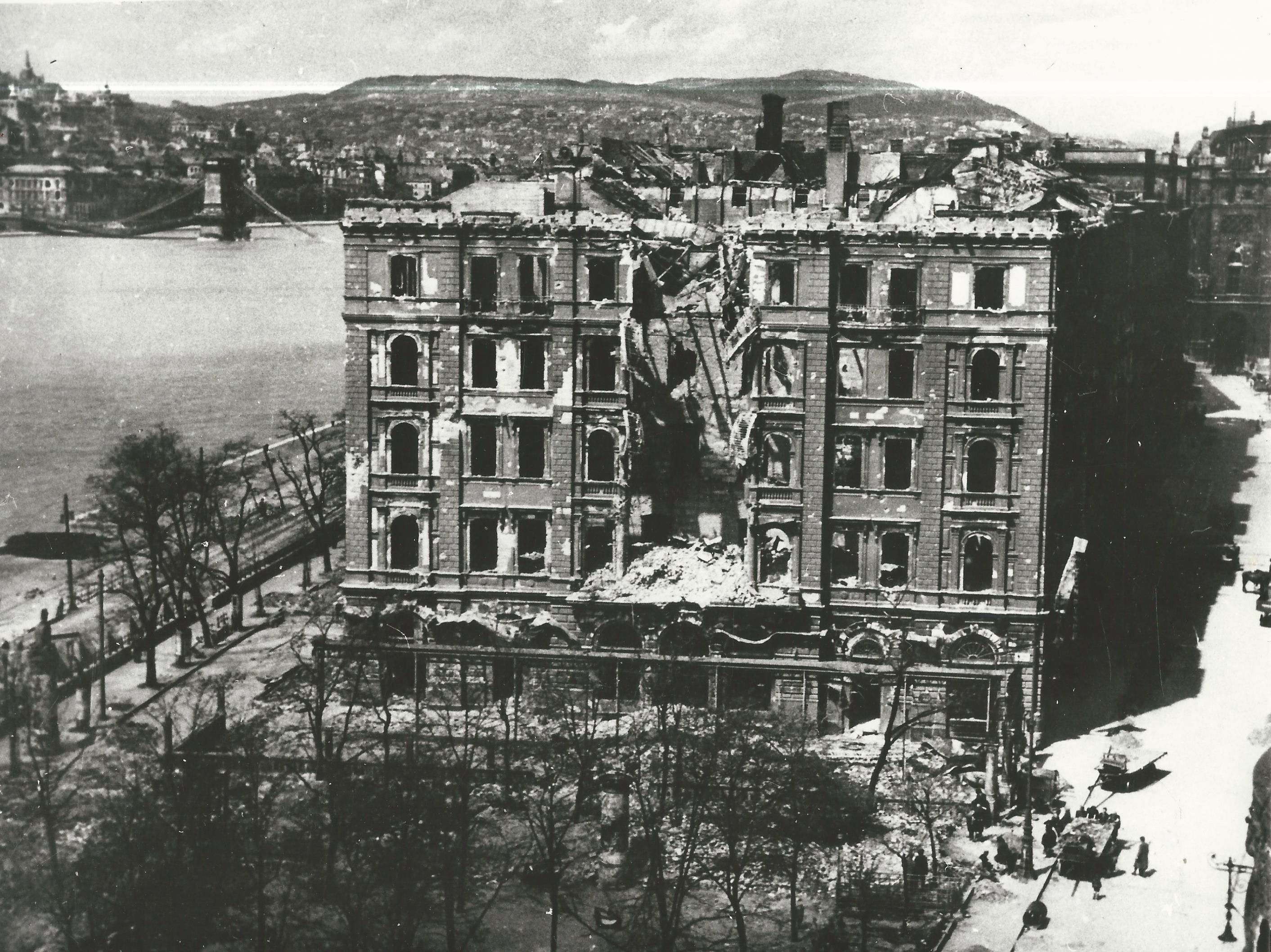
Ruined facade of the Carlton Hotel in 1945 (Source: Hungarian Museum of Trade and Hospitality - Budapest, No.: VF 28502)
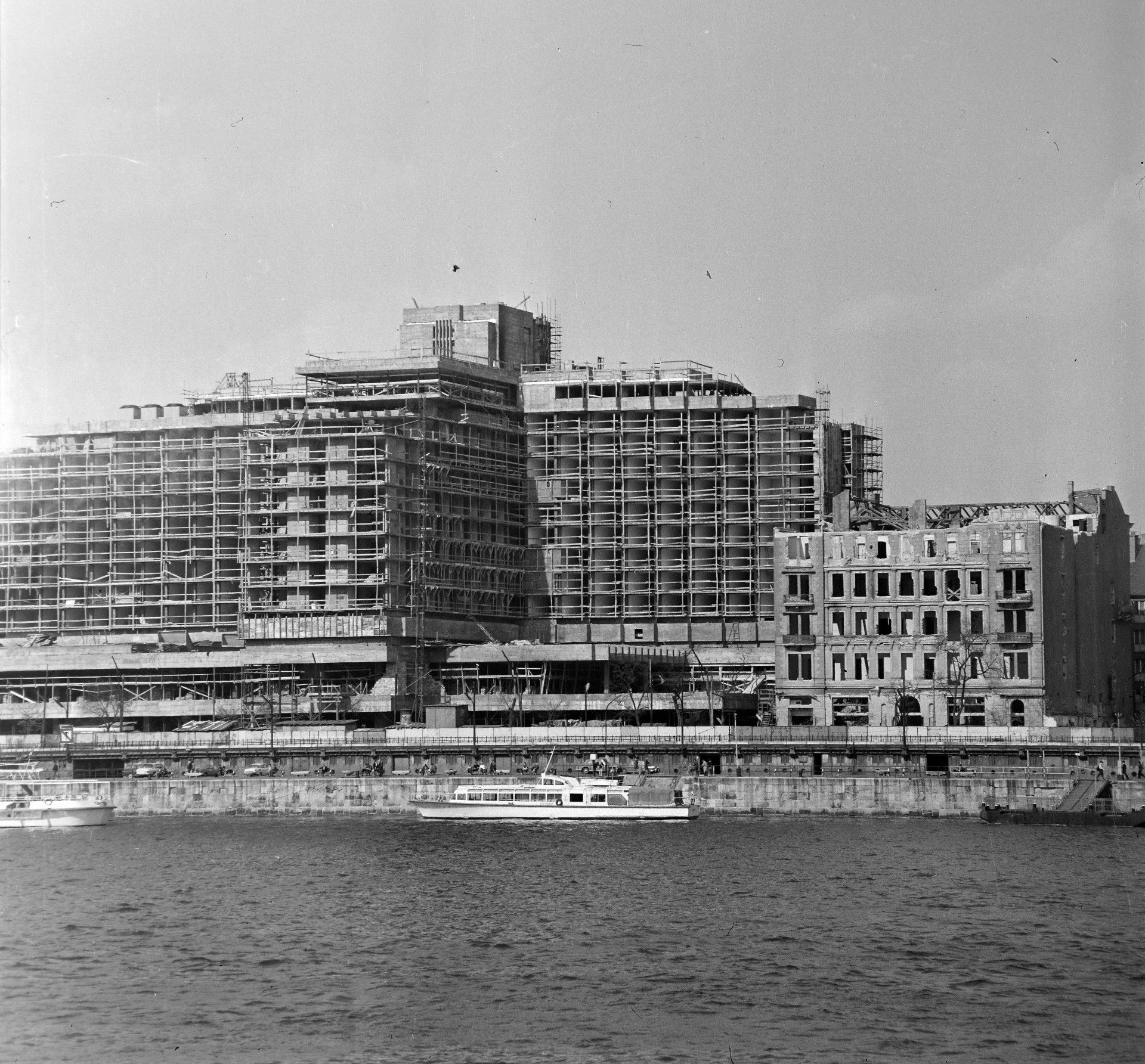
The Danube Intercontinental, under construction, next to the Danube Hotel, prepared for blasting in 1969 (Source: Fortepan/No.: 126659)
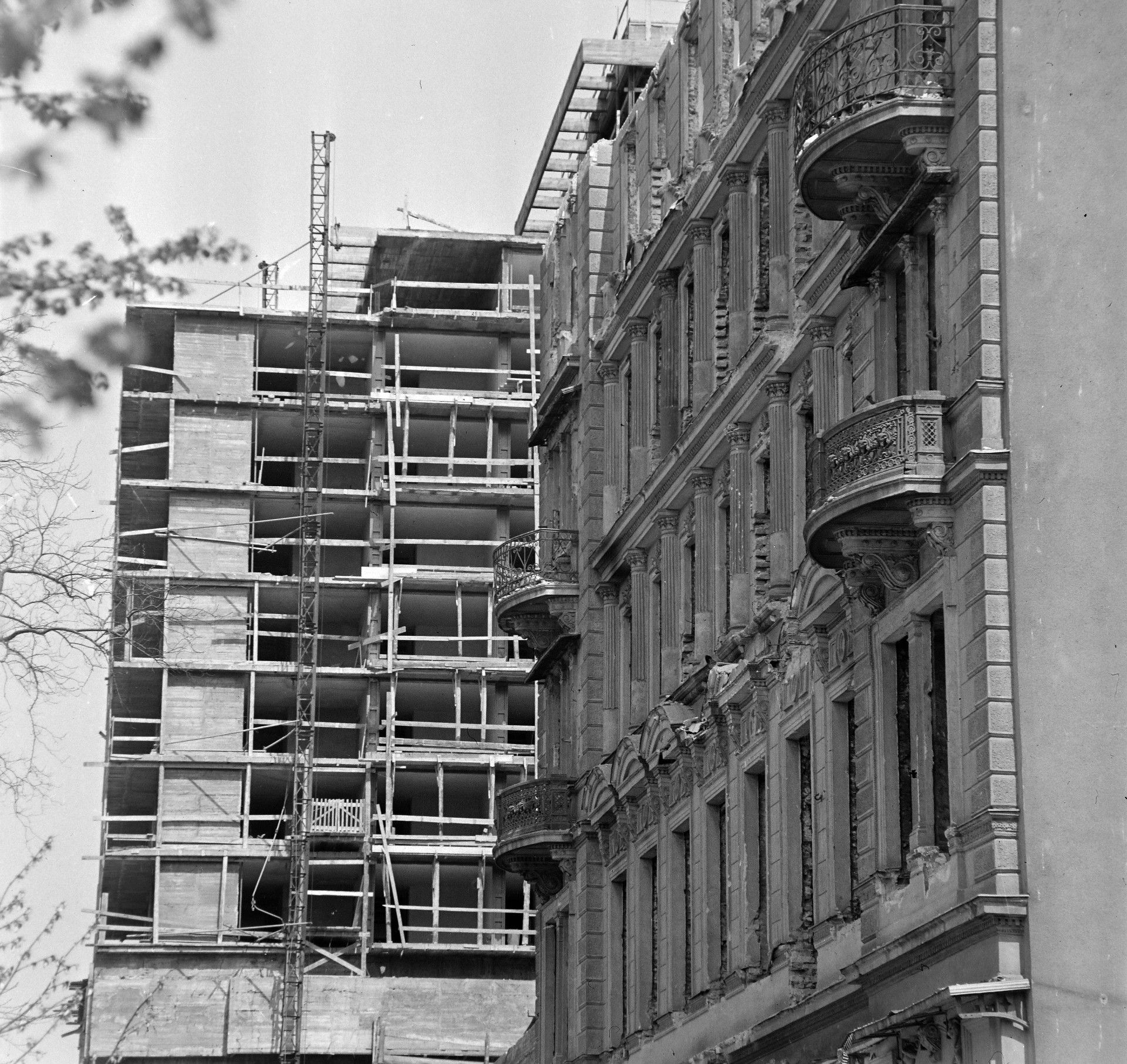
Demolition of the Danube Hotel, the building is prepared for blasting. In the background, the Danube Intercontinental under construction in 1969 (Source: Fortepan/No.: 126661)
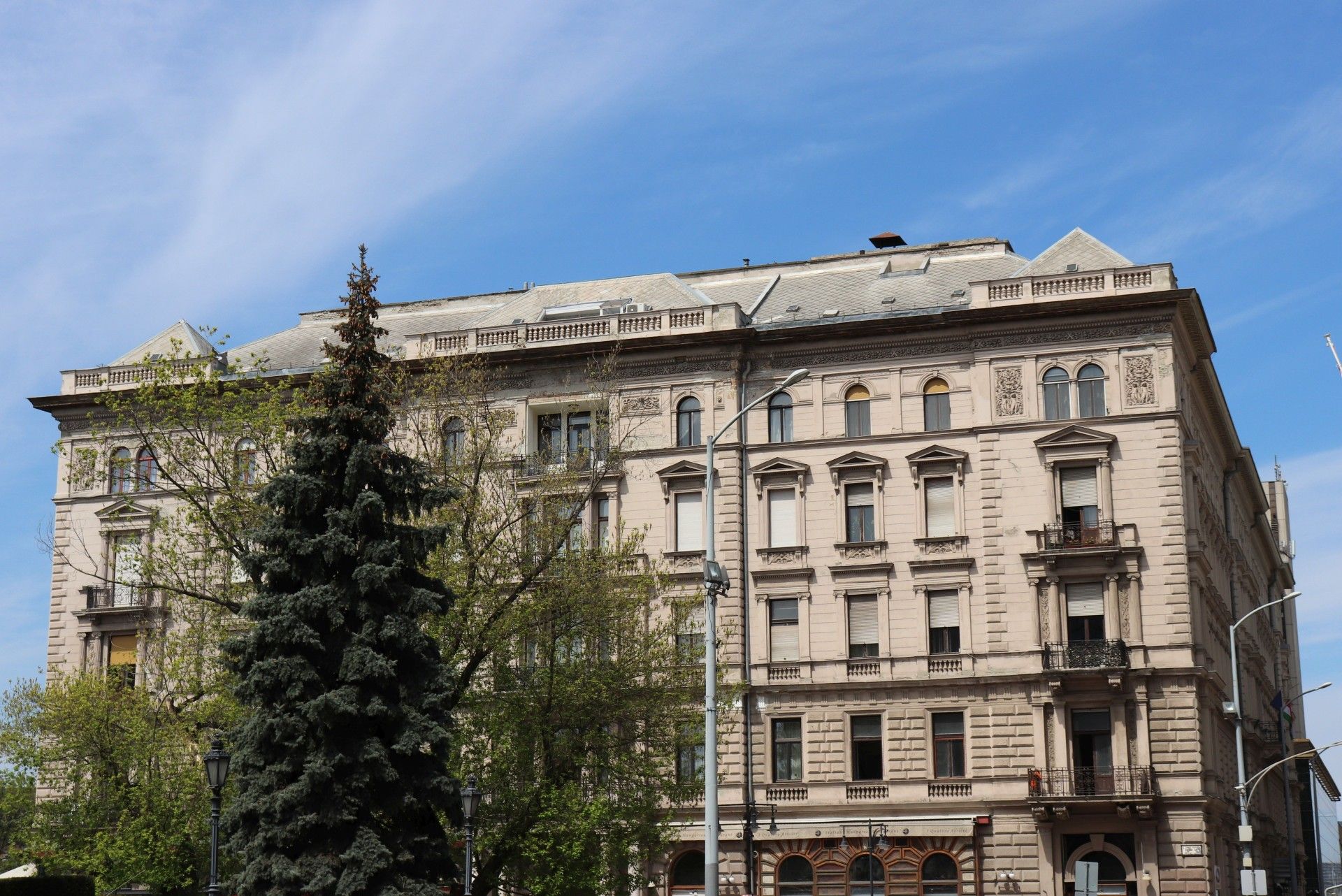
The only surviving building of the Danube Promenade, the Thonet Court today, photographed from Vigadó Square. (Photo: Zsolt Dubniczky/pestbuda.hu)
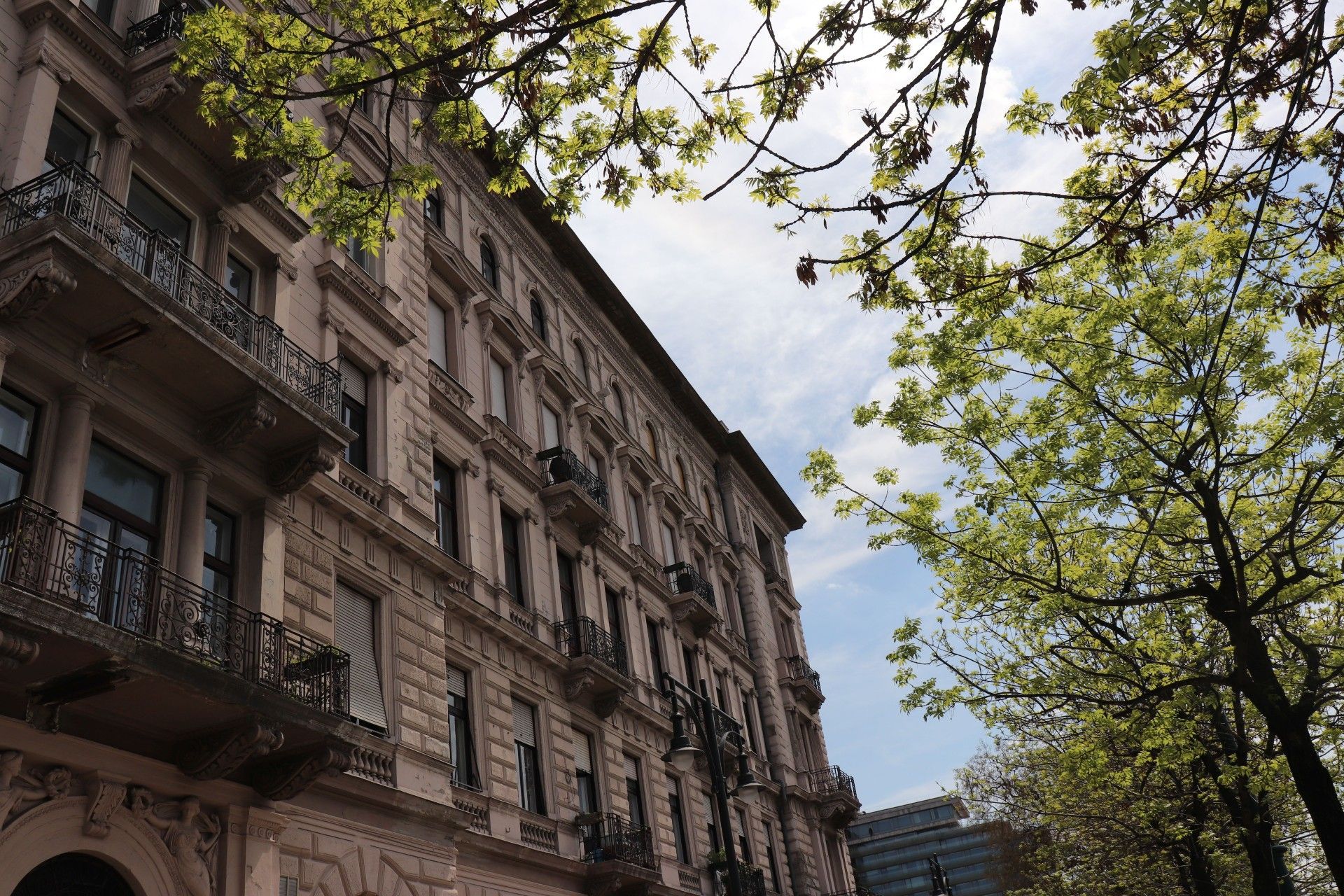
The facade of the only surviving building of the Danube Promenade, the Thonet-Court, facing the promenade today (Photo: Zsolt Dubniczky/pestbuda.hu)
It took more than twenty years for the area to regain the same function and role that it held from the late 19th century for more than 50 years to the mid-20th century. However, the public is still divided by the sight of modern-style and monumental-looking hotel buildings.
To the north of the Vigadó, the Dunapalota was replaced by the InterContinental Budapest. To the south, on the site of the former Hungária, Bristol and Carlton Hotel complex, the Danube InterContinental (now Marriott) Hotel was built.
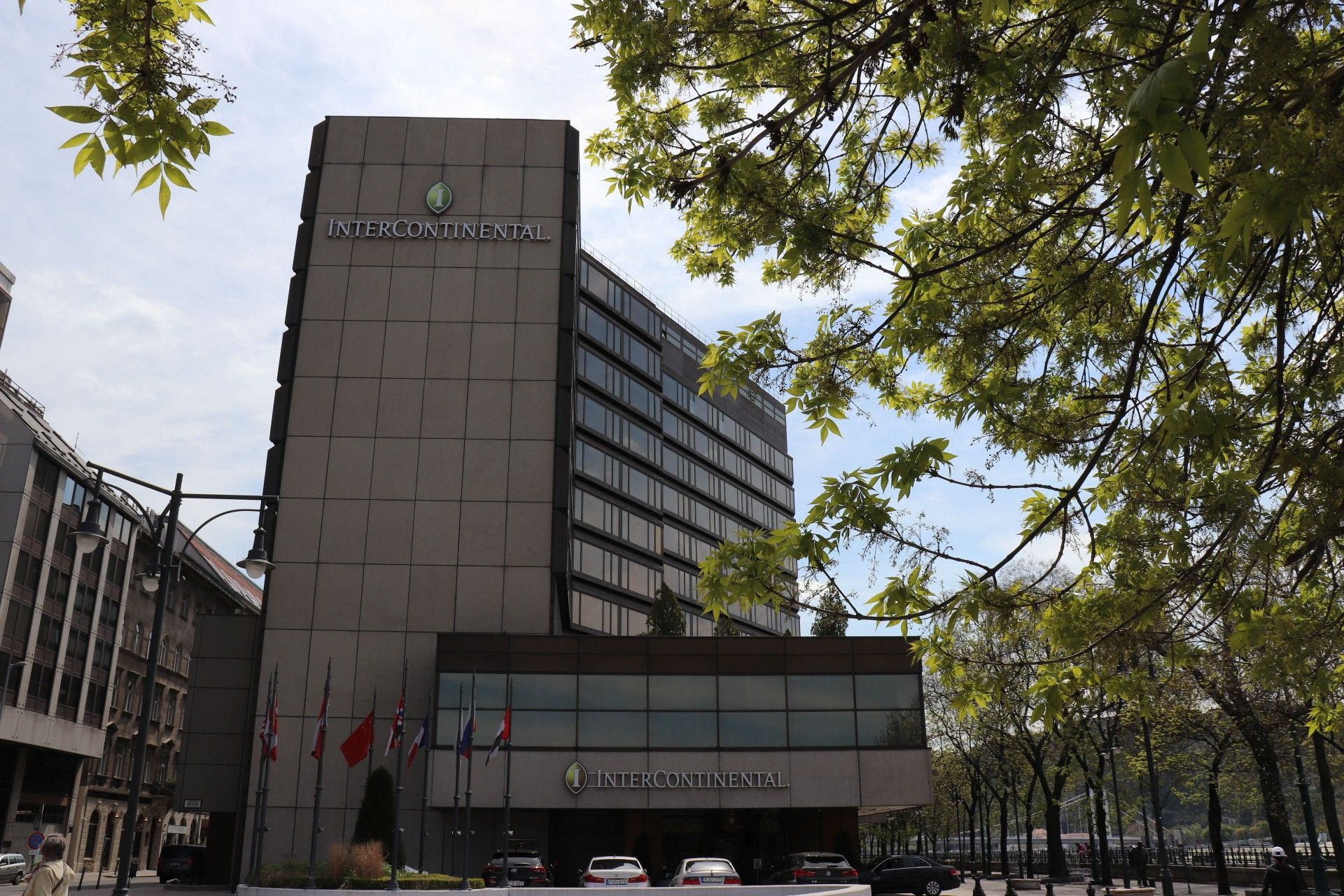
The InterContinental Budapest, built on the site of the Ritz, later Dunapalota Hotel, today (Photo: Zsolt Dubniczky/pestbuda.hu)
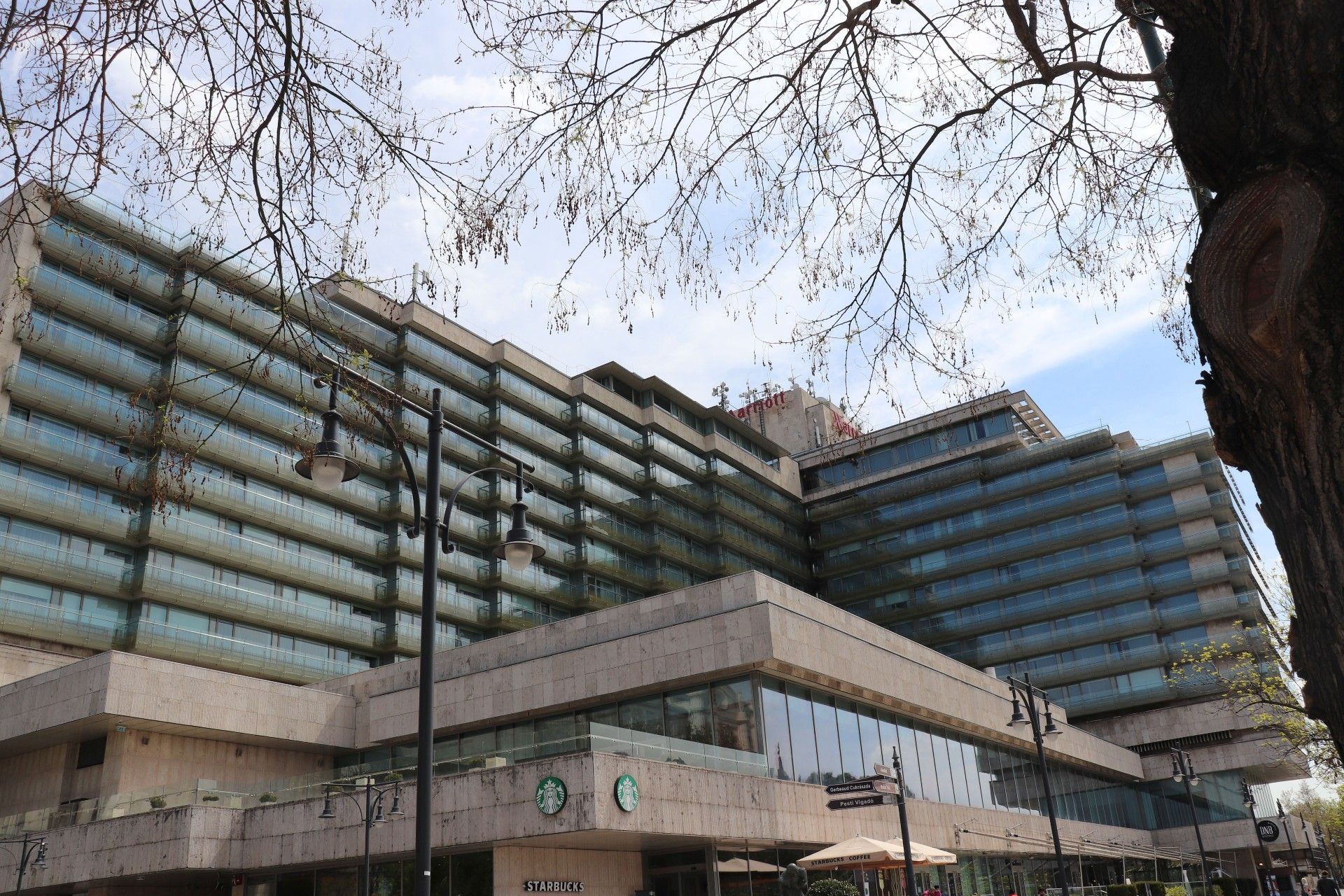
The Danube Intercontinental (now Marriott) hotel, located on the site of the former Grand Hotel Hungária, Bristol and Carlton Hotel complex (Photo: Zsolt Dubniczky/pestbuda.hu)
Cover photo: The six-storey Ritz Hotel, which operated under the name Dunapalota from 1916, photographed by György Klösz (Source: Fortepan/No.: 82608 / Budapest Archives Ref. no.: HU.BFL.XV.19.d.1.08.083)

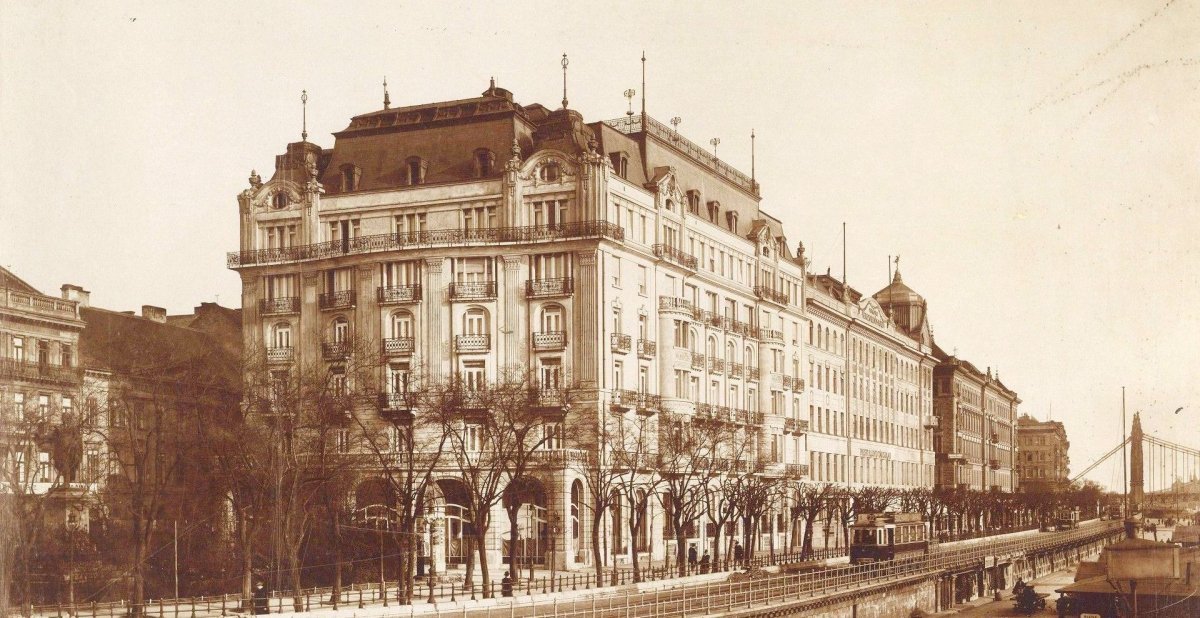



































Hozzászólások
Log in or register to comment!
Login Registration